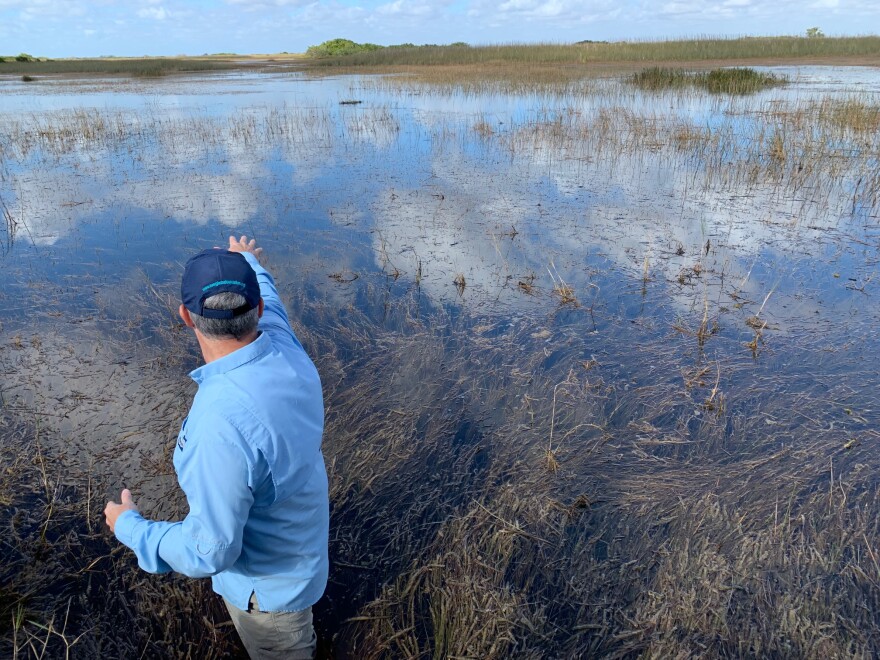Florida’s troubled Everglades received a billion-dollar windfall last month when the White House slipped a handful of environmental restoration projects into a new infrastructure spending package. The trillion-dollar plan is intended to address the national backlog of neglected roads, ports and other projects.
WLRN's Jenny Staletovich explains what a billion dollars will buy and how it could improve conditions in one of the world’s largest wetlands.
JENNY STALETOVICH: Hiking across a shallow channel in the Everglades Big Cypress swamp or airboating across the its river of grass, it’s hard to imagine that the maze of wetlands, prairies and cypress domes that were once the size of Connecticut are in deep trouble.
WLRN is here for you, even when life is unpredictable. Our journalists are continuing to work hard to keep you informed across South Florida. Please support this vital work. Become a WLRN member today. Thank you.
During the dry season, decades of flood control have left the wetlands starved for fresh water. When it rains, pollution from farm fields, city streets and neighborhood lawns ignite algae blooms in coastal waters or choke the inland wetlands with cattails. Add sea rise to the list, and the future for the low-lying Everglades that protect drinking water for about 8 million people looks grim.

There’s a plan to fix the marshes, but it’s way behind schedule and the cost has ballooned to $23 billion. The state and federal Army Corps of Engineers split the cost.
Now, a $1.1 billion dollar windfall from the Biden administration could bring some relief.
Eve Samples is executive director of the Friends of the Everglades.
EVE SAMPLES: This $1.1 billion was designed for projects that could be completed start to finish or close to start to finish.
STALETOVICH: Samples says the mandate for the White House money is clear: finish three smaller projects that have been dragging on for years. Also, map out costs on two bigger projects so they don’t get mired in delays.
SAMPLES: And politically, you can see how that might be an appealing idea, right?
STALETOVICH: The Corps confirmed the strategy in an email, but declined to be interviewed.
(Airboat soundbite)
STALETOVICH: I met with Steve Davis at an airboat concession along the Tamiami Trail. Davis is chief science officer for the Everglades Foundation.
One of the projects helps undo some of the damage caused by the old highway that dammed up the Everglades in the 1920s and started decades of cascading problems. Without freshwater, peat soil has started to collapse and miles of seagrass have died over the years. The Army Corps and National Park Service are building a series of bridges. Now they need a bigger pump to move the water.
STEVE DAVIS: It's just trying to capture those flows and steer as much of that water into [Everglades National Park] as possible.
STALETOVICH: Another project would finish a reservoir started 15 years ago. It’s part of the larger restoration of the Indian River Lagoon, where pollution has killed off most of its seagrass and left a record number of manatees to starve to death.

DAVIS: It allows us to capture some of those flashy, low water quality flows not unlike what wetlands would do naturally.
STALETOVICH: Plans for a larger project that focuses on Biscayne Bay and southern marshes would restore the wetlands that fight sea rise and storm surge.
Another plan...
(hiking soundbite)
...focuses on the remote west edge, where the marshes converge with the Big Cypress Swamp. Tony Pernas is a botanist who retired this winter as resource manager at Big Cypress after 40 years with the National Park Service.
TONY PERNAS: Here is this kind of like the forgotten area. So nobody really paid much attention to it.
STALETOVICH: We recently went on a hike, not far from where a canal cuts across the preserve onto Miccosukee Tribal land. The canal drains farm fields to the north, carrying pollution from fertilizer.
PERNAS: It's definitely something that needs to be addressed.

STALETOVICH: The spending is the single largest investment in the Everglades ever made.
Florida’s Republican governor Ron DeSantis, however, has been quick to find fault.
RON DESANTIS: It was a big missed opportunity for the federal government to not have put just not even one dime that went to the EAA reservoir.
STALETOVICH: This Everglades reservoir has been championed by DeSantis as key to stopping pollution on Florida’s wealthy Treasure Coast and west coast. It’ll include pollution scrubbing marshes, which the state is paying to build. And getting it done wins a lot of political cache in Florida.
Republican Congressman Brian Mast represents the Treasure Coast.
BRIAN MAST: That's the Biden administration sending a middle finger over to Florida, and this is what we see over and over again.
STALETOVICH: But at an estimated $2-plus billion dollars, the reservoir is more expensive than the infrastructure plan’s entire national allotment for environmental projects. Army Corps officials said that’s what kept it off the list.






